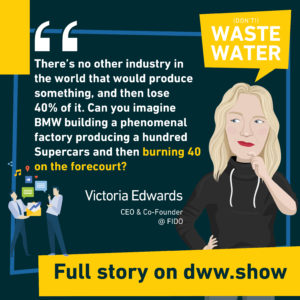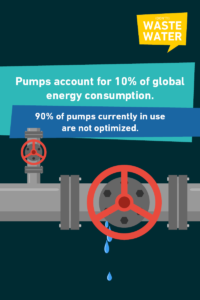Our planet commands us to reach net zero carbon by 2050. This strongly impacts the Water Industry! Why? Simply because our sector’s direct emissions are significantly larger than aviation or all the cars on the road in the USA.
How can we collaborate across the water value chain to reduce our greenhouse gas emissions? What needs to change in our energy, waste, and sustainability approaches? What are the tools and the shifts in leadership and management it involves?
Let’s review!
Table of contents
5 Experts to Light our Path towards Water Net Zero
I was joined on stage for the recent Global Water Summit by 5 water industry experts to review how the Water Sector intends to lead the race to zero. If you’d like to dive straight into their respective wisdom, just click on their cartoon stunt doubles ⬇️





What is net zero?
It’s pure mathematics: you take the greenhouse gas your activities produce, and you subtract the GHG you remove from the atmosphere. If you reach equilibrium, you’re at net zero! Above, you’ll be in trouble – especially given the Paris agreements. And if the result is negative, you’re a good pupil.
Now, if you’re just starting out with the carbon topic as I do – shame on me – there’s one more thing to understand about net zero. It doesn’t mean you’re not emitting any carbon or greenhouse gas. It means that you offset at least as much as you emit.
This is why we see different kinds of pledges between the net zero commitments and the zero emission ones. And of course, the logical order is to start with net zero to ultimately reach zero emissions.
What does it mean for the Water Industry?
Water handling is an energy-intensive process. Be it water supply, conveyance, treatment or distribution, wastewater collection, treatment, or discharge, all of these process steps involve a degree of energy intensity.
| Water Cycle Segment | Energy Intensity (kWh/m3) |
|---|---|
| Water supply and conveyance | 0 – 3.6 |
| Water treatment | 0.03 – 4.2 |
| Water distribution | 0.18 – 0.32 |
| Wastewater collection and treatment | 0.29 – 1.23 |
| Wastewater discharge | 0 – 0.11 |
| Water recycling | 0.11 – 0.32 |
Altogether, the water sector is directly responsible for up to 10% of the Worlds carbon emissions. That’s about five times more than the aviation sector! And it could ironically worsen if we were to reach the UN SDG 6. Indeed, that would mean an additional 44% of treated wastewater, representing an additional energy burden. And additional process emissions – we’ll come back to that.
Yet, that’s still an average figure: depending on the availability and quality of water, the carbon impact may differ. While good quality surface water comes “carbon free,” desalination involves about 3 to 4kWh/m3 – and the associated carbon impact.
So, if the World is decarbonizing, it will rapidly end up pointing at the Water Industry and asking us to do the same. Now don’t get me wrong, that’s an opportunity!
What is a “Good Net Zero?”
When discussing with Maria Manidaki, it rapidly became clear to me that we had three ways to solve the carbon riddle. Option one: we consider ourselves green, evaluate how much carbon we emit, and “just” offset it.

Now, at the scale of the Water Sector’s emissions today, that may represent unrealistic amounts of trees to plant, and atmospheric carbon to capture…
Option two: we declare our emissions to be mostly energy-related, and hence wait for the energy sector to do its work and turn 100% carbon free to pat ourselves on the back and claim we’re now the greenest industry there is. Problem: that’s quite a passive take on the matter. And worse, it doesn’t solve for our direct emissions – especially on the wastewater side of the equation.
Hence, Maria introduces the concept of a “Good Net Zero:”
That’s why we may want to go for option three! We have a unique opportunity today to invest in the right approaches. There are countless options to do so (we’ll review some in a jiffy!), and one simple truth. The investment will cost the same today as in a somewhat distant future.
But if we move now, we can start reaping the benefits straight away.
Now, to reap the full benefits of the opportunities, we have to agree on some definitions first:
What is a carbon footprint?
A company’s carbon footprint is the total amount of greenhouse gases that are generated by its direct actions.
For many industries, this is a very convenient and relevant measurement. But is it for the Water Industry? I’d say, not across the supply chain, let me give you an example.
At GF Piping Systems, we strive to put together the most reliable way to convey water. Our carbon footprint is hence defined by all the carbon emitted while producing our pipes, fittings, actuators, or sensors. But what if we were producing pipes, with a stupidly high inside roughness? It may trigger much higher pumping needs – hence a whole lot of energy.

Yet, that wouldn’t impact our footprint: we don’t supply the pumps, and we don’t operate them. So the utility’s footprint would be heavily degraded – while we would still be good pupils.
This is why, beyond carbon footprint, there’s an additional measure that’s more meaningful across the water value chain:
What is a carbon handprint?
The carbon handprint is the greenhouse gas impact of a product when used by a customer. Said differently, the carbon handprint of a supplier is the way he impacts the carbon footprint of the other steps in the value chain.
And in the (stupid, of course) example I took before, our very rough pipes would have a terrible handprint.
So, that is probably the best metric to look for, to assess the water industry’s supply chain’s impact on the race to net zero water.
Should you decide between carbon footprint and handprint?
Now, if handprint is the best metric, why shall we still care about footprint? There’s a psychological element to it. As the Water Industry’s supply chain, we have to demonstrate some leadership and show the way. As Lisa Marchewka shared during the conference:
This is why, even if their customers use 65’000 times more water than they do, Evoqua still set some ambitious footprint targets.
What does a carbon net zero water future involve?
If we decide to walk the talk, it means we’ll have to step out of “business as usual” approaches and review our practices.
The good news is, as Xylem showed, that there are plenty of low-hanging fruits in that endeavor. For instance, 50% of energy-related emissions from the wastewater side of our sector could be eliminated with existing technologies. And all of that, 95% of the time at zero or negative costs!
And as Austin Alexander recalls, it is our duty as a supply chain to support our customers in reaping those benefits for the planet and for themselves:
Where shall we start? Here’s a non-exhaustive list of the items, we might want to collectively begin with:
Water savings
Often referred to as a low-hanging fruit – to the despair of my estimated colleague, Olivier Narbey – reducing Non-Revenue Water is the first stop on our path to net zero.
Every drop of treated water that goes missing represents energy that has been spent for nothing, and hence a carbon impact. A fact Victoria Edwards visually reminded us of!

Energy savings
We’re using plenty of energy in the various stages of water management – as shown in the table above. A good portion of it hides in network pumps, which can be optimized quite consequently. As David Lloyd Owen recalls in his “Global Water Funding” book, pumps account for 10% of the World’s energy consumption. And Grundfos estimates, that 90% of them are not optimized!

The next section of the Water Cycle where energy is misused is probably the aeration tanks in wastewater treatment plants. They account for 60% of a plant’s energy use! And even though it is probably the best we can do today, the activated sludge process still has this drawback of using energy to… destroy energy. Remember how wastewater is actually liquid energy?
It’s not about turning the sector on its head in a couple of months, but as Stephane Bessadi recalls, we can invest today in the innovations that will help solve those challenges tomorrow.
Process emissions
So far, we discussed energy, which is a good thing to reduce, for sure. Now, if the full electrical grid was to become renewable, the water industry could still gobble gargantuan amounts of energy and be carbon neutral. Probably not sustainable, but carbon neutral!
But along our treatment processes – and especially in WWTPs – we will keep emitting greenhouse gases. And as Maria explains:
What are our options here? Well to start with, we could be extreme:

Much more realistically, we shall strive to better capture the methane, and leverage more anaerobic processes to limit NOx emissions.
… or again, nothing against activated sludge, think of new alternative technologies, such as supercritical water oxidation. Did I already mention that wastewater is liquid energy?
One thing’s for sure – wastewater looks like low-hanging fruit. Yet, as Susan Moisio recalls, there’s a bigger picture:
Renewable power
And where would this investment need to go? Well, renewable power is an option. Indeed, water and wastewater facilities often feature large footprints, that may be well suited to installing some solar power. The same applies to small network hydraulic production tools – we’ll have to get creative! Now, there’s probably even more potential in:
Biogas & Hydrogen
Biogas produced in a sludge digestor is by definition carbon neutral. That makes it a good prospect in the race to net zero. Now imagine, taking that biogas and turning it even greener: that’s the promise of turquoise hydrogen. Here, you’d be taking a carbon neutral good (biogas), precipitating its carbon in graphite, and turning the remaining into hydrogen.
I’m only scratching the surface here, but I hope you realize, there’s a whole picture to address.
Leveraging the right tools to reach Net Zero as the Water Industry
So by now, we see where we could be acting. But we still need to do that in a purposeful, methodic way! That’s where frameworks, standards, and toolboxes kick in.
Calculation tools & design considerations
The Asian Development Bank has for instance developed a Screening Tool for the Energy Evaluation of Projects (STEEP). It combines a support document that recaps all the advice they collected in pilot and field projects with an XML calculation sheet.
You can download it for free, and widely use it!
Rethinking procurement
This is a clear outcome of Water UK’s routemap development steps. If we want to move beyond just intentions to change our approach to projects, we need to walk the talk. And that involves integrating the net zero water criterion into procurement procedures.
The water industry’s supply chain can well align to deliver on the promise, but it needs the right nudges from the ones at the top of the foodchain.
Defining new standards (e.g., PAS 2080)
Procurement will have to evolve to adapt itself to the new normal. But that section of organizations won’t move without a strong signal from its leadership. That’s where management kicks in on the road to net zero water!
But how? PAS 2080 answers this question by providing guidelines, best practices, and an up-to-date take on the subject. It will be published end of May, I’ll make sure to share it here (stay tuned).
Aligning the supply chain
The Water Industry is a complex beast from its end users to its bolts and nuts suppliers through all the layers of OEMs, EPCs, Engineering companies, and consultants. But it takes a village to raise a child! And if we want to hit the net zero mark, we’ll have to team up.
This is yet another reason why events like this year’s Global Water Summit are crucial.
Best practices in the Race to Net Zero Water
As we’ve seen, and as I hope I convinced you, it takes a village to win the race to net zero water. But where is that village? The obvious answer is, in the UK; which is the fast mover when it comes to setting ambitious carbon goals in the water sector.
But this very special water scene is not alone on that road:
81 utilities that pave the way
Global Water Intelligence keeps track of the utilities with net zero targets. Beyond the UK they’re to be found in Denmark, Australia, Canada, Chile, France, Germany, and many other places, and serve a total population of 230 million people.
In a typical bell curve, those are our first 3%. It’s not much, but it’s something. So let’s take our pilgrim sticks, and go out to convince the early and late majorities to join the race by 2025.
Early Adopters in the Water Industry
The race to net zero in the water sector also has its supply chain, early adopters. Companies like Xylem, Evoqua, Jacobs, or MottMacdonald – so, my panel for this exploration so far – all offer brilliant examples
Are you joining the race? Let me know, and I’ll call you out here!

